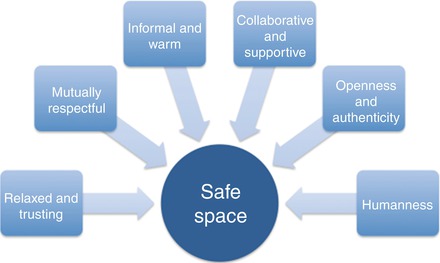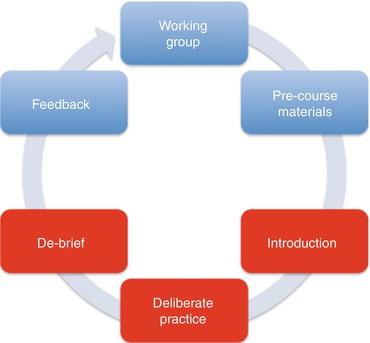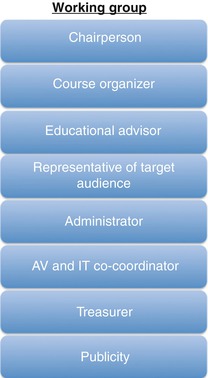Fig. 8.1
Achievement of appropriate deliberate practice
So with the above end in mind is it time to start designing your course? Pause and before committing a lot of your time and probably other people’s time to the process ask yourself the simple question. Why?
Have you been asked to set up a course? Do you simply have a desire to set up a course to teach something that you believe is not being taught elsewhere? Have you been approached by a company or a specific group? The reason you need to ask these questions is because your motivation will be tested! There will be times both during the planning, running and wrap-up phase of any course, however well planned, however well designed and however well run that your motivation will be tested. In general you will have to deal with unfamiliar situations, repeated negotiations and divergent expectations. So as with any project, the reason why has to be a good one for yourself and for those around you.
We have designed this chapter so as to provide some general advice that has come from running many courses and conferences over the years; specifically ones concerning surgical skills and arthroscopy. The various sections can be used as a reference tool that follows the timeline that we recommend you follow. The final two sections of the chapter are Tips and Tricks and Do’s and Don’ts. We recommend that you keep in mind a couple of acronyms. These have been popularised in the management world and will help you keep on track and keep your focus. SMART objectives, KISS, First things First and The Devil is in the Detail.
8.2.1 Using SMART Objectives
This refers to objectives that are specific, measurable, achievable, relevant and time bound. For example, the main objective of your course may be to deliver basic arthroscopy skills. With reference to the other chapters in this book you will be able to be specific as to what basic arthroscopy skills are and you will be able to know how best to teach them. You should set out to measure whether your course has taught these skills to your participants and that the goals you set on the course where achievable. You will seek feedback that the course was relevant to their day-to-day activities. Throughout that process you will ensure that you, your faculty and the participants are time bound by a published programme.
8.2.2 KISS
Keep it simple stupid refers to the fact that with every layer of complexity there is further potential for something to go wrong or a further level of potential misunderstanding. So whenever possible simplify, from the title of your course, to the slides in a presentation to the language used to describe a concept.
8.2.3 First Things First
W H Auden in his poem of the same said, ‘Thousands have lived without love, not one without water’. You will have attended a course I am sure when 80 % of the time was spent doing other things apart from the practical aspect that you had come to learn. The many things that we will cover in this chapter have their place; however, the key will always be the practical aspect and it is vital that you consider that first thing first at all points along your planning and implementation of your course.
8.2.4 The Devil Is in the Detail
As in surgery it is aspects of course design. To illustrate this we will consider the timing and length of refreshment breaks.
Routinely we would recommend four refreshments breaks in a day-long course, one on arrival, mid-morning, lunch and mid-afternoon. So how long should these be? Your own experience of attending a course will tell you that refreshment breaks can be anything from 10 min up to 2 h. So when you are determining the length of your own breaks the detail is in what you and your faculty consider their purpose to be. The refreshment break on arrival should be considered an opportunity for people to mingle and a time to ensure that the administrative staff can deal with any last-minute housekeeping issues. The programme must show that this refreshment break is considered to be for that purpose i.e. (Registration (coffee and light breakfast)). The next refreshment break should be mid-morning and long enough that it can be shortened! It should take place close to rooms that your practical’s are taking place in and you should ensure that there are enough toilets and that they are well signposted so that toilet breaks do not delay participants and faculty to making it back in time for the next session. The lunch break should be honestly planned with adequate time for visiting sponsors stands if that is required, whilst still having time to sit down and reflect on the course so far. The afternoon refreshment break should be just over an hour after lunch so as to coincide with the peak lethargy of everyone on the course brought about by digesting lunch.
So you can see that just taking into account the refreshment breaks, the detail can be quite significant and it is this detail that you and your working group must work through so as to get to right solution for your course.
8.2.4.1 Providing a Safe Space
A course provided to orthopaedic surgeons must follow an adult education approach [4]. It is vital that throughout the process of designing your course you focus on providing an educationally safe space as described by Malcolm Knowles and colleagues [5] (Fig. 8.2).


Fig. 8.2
Requirements for a safe learning space
8.2.4.2 Course Cycle
Every course should proceed through the course cycle as illustrated in Fig. 8.3. The blue elements occur outside the period of time the course is taking place, the red elements during the course.


Fig. 8.3
Description of the course cycle
It is vital that as early as possible in the genesis of your course you set up a fully functioning working group (Fig. 8.4). This is the group of people that you need to bring together to develop your course and ensure that all the aspects of the course that you need and as many as possible of those you want are incorporated. Each person on the working group can take up one or more roles. The meeting of the working group should be realistically planned with the benefits of a face-to-face meeting being balanced with its feasibility. There are multiple options such as videoconference calling which are far more beneficial than an email trail for brainstorming ideas and preventing misunderstandings and delays in processing of ideas. We shall now cover each of the roles and at the same time cover the key aspects of their responsibilities.


Fig. 8.4
Working group elements
8.2.4.3 Chairperson
This is the leader of the working group and will be the person who is considered the most experienced in the field that is to be taught on the course. Ideally this person will have a recognisable name locally, nationally or internationally depending on the targeted audience. Ideally he or she will have taught on many courses beforehand will be able to bring their insights into how to provide the best course possible.
Stay updated, free articles. Join our Telegram channel

Full access? Get Clinical Tree






